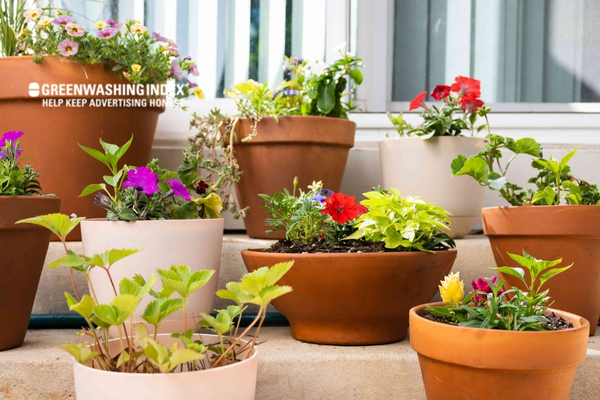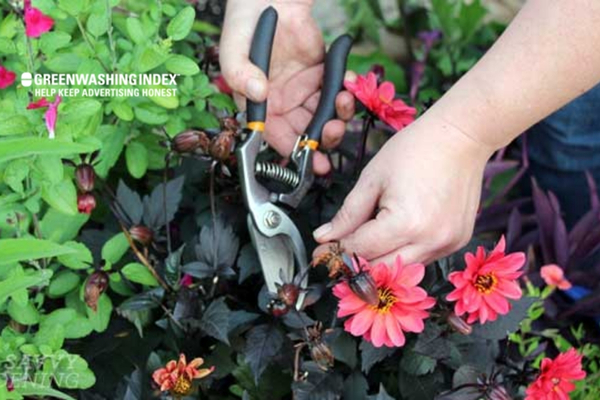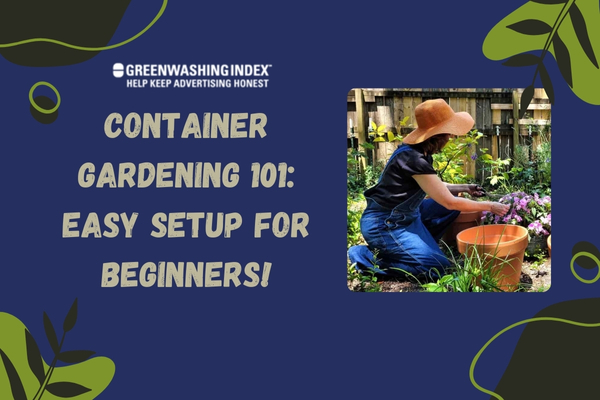Welcome to the world of container gardening, a delightful way to grow your own plants, even in the smallest of spaces! Have you ever peered out at a bare patio and dreamed of it bursting with color and life?
Or maybe you live in the heart of the city, where traditional gardens are but a distant dream. Worry not! Container gardening is here to turn those dreams into lush realities – and it’s easier than you might think!
Starting your own container garden can be as simple as gathering pots, filling them with soil, and planting some seeds or seedlings. However, details matter if you want those plants to flourish. The right containers will give your plant buddies enough space to grow while making sure their roots aren’t swimming in water.
With nutrient-rich soil tailored for potted friends and an arrangement that gives each plant its own sunny spot without overcrowding its neighbors, you’ll have an undemanding garden thriving on your doorstep or balcony.
What You’ll Discover Here:
- Step-by-step beginner guidelines for container gardening.
- Expert tips for selecting the perfect pots and soil.
- The secrets for maintaining a vibrant mini garden year-round.
- Personal experiences that bring charm to urban gardening.
Why You Need To Start Your Container Gardening Journey?
Starting a container garden is exciting! Imagine growing your own veggies or flowers in pots. But before you begin, there are some important things to know.
Choosing Containers for Your Garden
When it comes to container gardening, picking the right pot is key. It’s like picking a house for your plants. They will live and grow in it! So, let’s talk about what makes a good home for your potted plants:
- Size: Bigger isn’t always better. Choose a pot that matches the size of your plant. If it’s too big, your plant may not grow well because the soil can stay wet too long. This could cause rotting roots, which is bad news for plants.
- Material: Pots can be made from things like plastic, clay, ceramic, or metal. Plastic is light and keeps moisture well but might not last as long as clay or ceramic, which helps roots breathe better. Metal looks cool but can get very hot, which might hurt the roots.
- Drainage: This is super important! Good drainage means excess water can leave the pot so plant roots don’t sit in water and rot away. Make sure there are holes at the bottom of each pot.
Selecting Soil and Fertilizers
It’s now time to fill up those pots with some great soil – it’s like giving your plants a comfy bed with all they need to grow up strong:
- Soil Type: Not all dirt is equal when it comes to growing plants in pots. Use soil that’s made just for container gardening because it gets rid of water properly while keeping enough air for the roots.
- Nutrients: Plants get hungry too! Adding fertilizers gives them food to grow tall and healthy.
- Organic fertilizer: Comes from natural stuff like composted leaves or manure.
- Inorganic fertilizer: Made by people with chemicals to help plants grow fast.
Remember: Always read directions on fertilizer packages so you don’t overfeed or underfeed your green friends.
Picking Plants That Thrive in Containers
Not all types of plants love living in containers, so choose wisely:
- Vegetables: Some veggies love containers like tomatoes, peppers, lettuce, and herbs — perfect for gardeners who want fresh veggies from their balcony!
- Flowers: Lots of flowers do great in pots, too; petunias and marigolds bring bright colors, while lavender smells wonderful and brings butterflies around!
Think about how much sun each plant needs before you pick them out because some need lots of sunlight while others prefer shady spots.
By choosing just the right containers, giving comfy soil beds with plenty of food (fertilizer), and picking happy, potted-friendly plants — you’ve set yourself up for an amazing container garden journey! Happy growing!
Also Read: Pistachio Shells Compostability: Breaking the Myths
Setting Up Your First Container Garden
Starting a container garden is exciting. It’s a way to grow your own plants, even if you don’t have much space. If you’re new to container gardening, I’ll guide you through two important steps: picking the right spot and arranging your pots in a good-looking and practical way.

Location Selection for Optimal Growth
When I picked a location for my first container garden, I thought about sunlight and protection. Plants love sunlight, but too much wind or rain can hurt them. Here’s what to consider:
- Sunlight: Most potted plants need plenty of sunlight. Look for a spot that gets at least 5-6 hours of sun every day. A balcony facing the sun or a sunny part of the patio is often perfect.
- Shade: Some plants don’t like too much heat. If you live somewhere that is very sunny, find an area that gets partial shade in the afternoon.
- Wind: Strong winds can harm delicate plants or dry them out quickly—place containers where walls or other barriers can block some wind.
- Rain: Getting enough water is good for plants, but too much rain can flood pots and harm roots. Choose an area with cover overhead if your region gets heavy rains.
Once you find the best place for sunlight and shelter, make sure it’s also easy for you to reach with water and care for the plants.
Container Arrangement Strategies
After choosing the right spot for my container garden, arranging pots was my next step. It’s not just about making it look good but also about giving each plant what it needs to grow well.
Here’s how I thought about organizing:
- Height: Put taller potted plants at the back or in the center so they don’t block sunlight from shorter ones when put in layers.
- Grouping: Plant similar types together; herbs in one spot, flowers nearby but separate – this helps when watering as they often need similar care.
- Spacing: Give each pot some space so air can circulate; this keeps pests away and helps prevent disease spread between potted plants.
With these strategies in mind—prioritizing sunlight access while shielding from harsh elements—you will create a thriving space even if you’re new to gardening! Remember these simple guidelines as they will set up your container garden on track right from its roots!
Also Read: Old Electronics Disposal: Ultimate Recycling Tips Guide
Maintaining Your Container Garden with Ease
Gardening has a lot of big moments—like when flowers bloom or tomatoes ripen. But to get to those joys, the little things matter, especially in container gardening. Two key parts are watering and dealing with pesky visitors (I mean bugs and diseases, not the neighbor who always wants a tomato).

Watering Techniques and Schedules
Watering your potted plants is a bit like feeding a pet. You need to do it the right way, at the right time, so your plant stays happy and healthy. Here’s how I handle it:
- Check the soil: Before I water my plants, I always check if they really need it. I stick my finger about an inch deep into the soil. If it feels dry, it’s time to water.
- Morning is best: The perfect time for me to water is in the morning. This gives my plants a whole day to drink up before the night comes.
- Use water at room temperature: Cold water can shock the roots of your plant. That’s why I always use room-temperature water for my container gardening.
- How much to pour: My rule is simple – keep pouring until you see water coming out of the holes in the bottom of the pot.
- Avoid wet leaves: When watering, I try not to splash all over their leaves because that can lead to fungus problems or sunburn when hit by sunlight.
Dealing With Pests and Diseases
Sometimes, pests or diseases try making homes in my container garden. Here’s what I do when that happens:
- I inspect regularly: Checking on my plants often means that if bugs show up or something looks sickly, I spot it early, which makes dealing with it easier.
- Cleanliness is key: By keeping everything clean, from pots to tools, I avoid giving pests or diseases a place to start!
- Organic pesticides: If pests do arrive, organic options are my first choice because they’re safer for me and nature, too!
- Natural helpers: Sometimes, inviting good insects like ladybugs into your garden can help you fight off those pesky bugs naturally.
Being aware of good watering habits and staying alert for signs of pests will make your container gardening journey smoother and more enjoyable!
FAQs
How often should I fertilize my container garden?
You should add fertilizer to your container garden every two to four weeks. But watch your plants – if they look happy and healthy, you might not need to fertilize that often.
Can I do container gardening indoors if I don’t have outdoor space?
Absolutely! Container gardening is perfect for indoors. Just make sure your pots get enough light, either through a window or artificial grow lights.
What are some easy-to-grow vegetables suitable for a beginner’s
first container garden?
For beginners, try growing lettuce, radishes, or cherry tomatoes. They don’t need much space and are pretty forgiving when it comes to care.
Conclusion
Container gardening is a wonderful adventure, especially for beginners and those with limited space. It’s a process filled with excitement, from choosing the right containers to picking your favorite potted plants.
The joy of seeing your little urban garden come to life brings a unique sense of achievement. For me, each small step – selecting soil and fertilizers, arranging containers beautifully, or finding the perfect sunny spot – contributes to the big picture of a thriving container garden.
Throughout this journey, also embracing the learning curve when it comes to maintenance tasks like watering and dealing with pests has its own rewards.
Understanding these aspects can lead not just to blooming plants but also to an enriched gardening experience. With patience and care, you’ll learn that growing vegetables in containers is not just possible but incredibly fulfilling.
Key Takeaway Points:
- Start container gardening by selecting suitable containers with good drainage.
- Pick the right soil and fertilizer for thriving potted plants.
- Choose plant varieties well-suited for container life.
- Place your containers in optimal locations with proper sunlight.
- Maintain an aesthetic arrangement while considering plant needs.
- Develop effective watering techniques.
- Implement organic strategies to handle pests and diseases.



